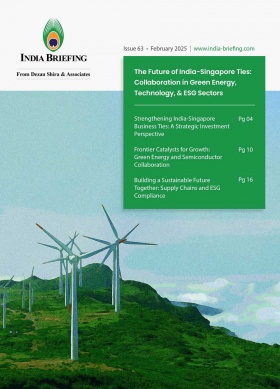India’s Updated Income Tax Return Forms for AY 2025–26 Explained
India’s income tax authority has implemented major revisions to the Income Tax Return (ITR) forms for the Assessment Year (AY) 2025–26, notably including updates to the rules governing capital gains reporting.
In response to these changes, the Central Board of Direct Taxes (CBDT) has extended the ITR filing deadline by an additional 45 days, providing taxpayers more time to comply with the updated requirements.
For the assessment year (AY) 2025-26, India’s Income Tax (IT) Department has released seven income tax return (ITR) forms. ITR-1 and ITR-4, which are primarily intended for small and medium taxpayers, were issued on April 29, 2025, while ITR-7, designed for trusts and charitable organizations, was notified on May 9, 2025.
These forms incorporate several updates, including a key modification in ITR-1 and ITR-4 requiring more detailed reporting of capital gains from listed equity investments. This change aligns with the tax rule adjustments for long-term capital gains (LTCG) introduced in the Union Budget 2024, which took effect on July 23, 2024.
CBDT extends ITR Filing deadline for AY 2025–26
CBDT has extended the deadline for filing ITRs for the Assessment Year (AY) 2025–26. Taxpayers who were originally required to file by July 31, 2025, can now do so by September 15, 2025, as per the latest official notification. This move aims to ease the compliance burden and facilitate a smoother filing experience.
|
New ITR deadlines for AY 2025–26 |
|
|
Taxpayer category |
Revised ITR due date |
|
Individuals, HUFs, AOPs, BOIs (non-audited cases) |
September 15, 2025 |
|
Businesses requiring audit |
October 31, 2025 |
|
Businesses subject to transfer pricing provisions |
November 30, 2025 |
|
Belated or revised return filers |
December 31, 2025 |
The extension was granted due to recent updates in the ITR forms to accommodate the new tax regime. As per the tax authority, these modifications required additional time for integration into both the online and offline return filing utilities.
Relief under Section 234A of the Income Tax Act, 1961
Under Section 234A of the Income Tax Act, 1961, taxpayers who submit their ITRs and pay any applicable self-assessment tax by the extended deadline will not be liable to pay interest for late filing. This section specifically deals with interest levied for delays in filing the ITR beyond the due date. Typically, if a taxpayer does not file their return within the prescribed timeline and has outstanding self-assessment tax (i.e., tax payable after adjusting advance tax and TDS), interest is charged at 1 percent per month or part thereof on the unpaid amount, calculated from the original due date until the actual date of filing.
This relief is particularly beneficial for salaried taxpayers, self-employed individuals, and small businesses—especially those who anticipate a tax liability after computing their total income and deductions but require additional time to arrange funds or complete tax calculations.
Excel utilities for ITR-2 and ITR-3 now available
India’s IT department has released Excel-based utilities for ITR-2 and ITR-3 forms on July 11, 2025. This will enable taxpayers with capital gains, cryptocurrency income, and other complex income sources to start filing their ITR for FY 2024–25 (AY 2025–26). It may be noted that as of July 14, 2025, only the Excel utilities are live on the IT department website; click here: incometax.gov.in/.
An applicant can download the Excel utility from the ‘Downloads’ section of the e-filing portal. After extracting the ZIP file, open the Excel sheet and input your details across the relevant schedules. Once completed, log in to the e-filing portal, upload the file, and submit your return.
Kindly verify the return within 30 days of excel utility form submission.
The online filing option for ITR-2 and ITR-3 is not yet enabled, and the department is expected to notify its availability separately.
Who should file ITR-2?
ITR-2 is meant for individuals and Hindu Undivided Families (HUFs) with income from various sources such as salaries, multiple residential properties, capital gains, and foreign income. It is also applicable to those earning more than INR 5,000 (US$58.56) from agriculture, directors of companies, and individuals with non-resident or RNOR (resident but not ordinarily resident) status.
Key updates to ITR-2 for AY 2025–26
- Separate reporting of capital gains before and after July 23, 2024.
- Capital loss on share buybacks can be claimed if related dividends are reported under ‘Income from Other Sources’ (effective from October 1, 2024).
- Asset and liability reporting is now mandatory only if total income exceeds INR 10 million.
- Improved disclosure for deductions under sections 80C, 10(13A), etc of the Income Tax Act, 1961.
- Taxpayers must now specify the tax deducted at source (TDS) section code in the return.
Who should file ITR-3?
ITR-3, on the other hand, is intended for self-employed individuals, professionals, and partners in firms. It covers income from business or profession, capital gains, and ownership of unlisted equity shares.
Key updates to ITR-3 for AY 2025–26
- Capital gains must be reported before/after July 23, 2024, in line with Finance Act changes.
- Capital loss on buyback claimable if related dividends are disclosed appropriately.
- Asset & liability reporting threshold increased from INR 5 million to INR 10 million.
- Section 44BBC introduced for taxpayers engaged in cruise or ship operations.
- Expanded reporting under deductions [Sections 80C, 10(13A)].
- TDS schedule now requires section code disclosures.
Revised ITR forms delay ITR-2 and ITR-3 utilities
While ITR form 1 and 4 were released on May 30, 2025, ITR 3 and 4 were delayed by 40 days due to extensive changes in these forms. Tax experts believe these forms are used by individuals with diverse and often intricate financial profiles, including multiple property holdings, capital gains, and foreign income. As such, the revisions introduced in the forms have made them more complex to implement electronically.
Key updates to ITR-1 for AY 2025–26
The IT department has introduced new rules under Category A on July 10, 2025, to enhance data accuracy and compliance:
- Rule 277: Individuals born on or after April 1, 2007, are not permitted to file ITR-1 for AY 2025–26. This ensures that the return is filed only by eligible taxpayers above the minimum age threshold.
- Rule 278: The exempt allowance claimed under Section 10(13A) in the salary schedule must match the value provided in Schedule 10(13A). Discrepancies between the two may lead to validation errors during filing.
Section 10(13A) of the Income Tax Act applies to salaried individuals who receive a House Rent Allowance (HRA) as part of their salary and pay rent for their accommodation.
ITR filing deadline extended to September 15
On May 27, 2025, the Ministry of Finance announced an extension of the deadline for filing ITRs for the AY 2025–26. The original due date of July 31, 2025, has been pushed to September 15, 2025.
According to an official press release, the extension was granted in light of the comprehensive revisions made to the notified ITR forms and the additional time required to ensure system readiness and the smooth rollout of ITR filing utilities.
Excel utilities for ITR-1 and ITR-4 released
India’s IT department released the excel-based utilities for ITR-1 (SAHAJ) and ITR-4 (SUGAM) for the AY 2025–26. This was officially notified on May 30, 2025, and is meant for offline reporting of income earned during FY 2024-25. Eligible taxpayers can choose between two ITR filing methods:
- Offline filing: Fill in the income details using the downloadable Excel utility and upload the completed return through the Income Tax e-filing portal.
- Online filing: File the return directly by logging into the portal and using the web-based form.
The updated offline document of ITR-1 and ITR-4 now includes a provision to report LTCG under Section 112A of the Income Tax Act, 1961, up to INR 125,000 (US$1,464). This is applicable only if there are no carried forward or brought forward capital losses.
Step-by-step guide to file ITR using excel utility
- Visit the official income tax e-filing portal.
- On the homepage, click on the Download option on the navigation bar.
- Download the relevant Excel utility form (ITR-1 or ITR-4). Click here: Download/Income Tax Returns AY 2025-26
- Fill in personal and income-related details offline in the Excel sheet.
- Validate the entries and generate the XML or JSON file.
- Upload the file on the portal to complete the filing process.
Taxpayers are strongly advised to verify their eligibility before choosing the appropriate ITR form. Using an incorrect form can result in delays or rejection of the return. Reading the form instructions carefully is crucial to ensure accurate and error-free filing.
Key capital gains reporting updates in the AY 2025-26 ITR Forms
The CBDT has released all the ITR forms for AY 2025-26, incorporating substantial changes to capital gains reporting. These updates aim to simplify filing requirements and ensure accurate tax reporting for various taxpayer categories.
CLICK HERE: Capital Gains Tax in India: An Explainer
Higher exemption threshold for LTCG
The Union Budget 2024 raised the LTCG exemption limit for listed equity shares and equity-oriented mutual funds from INR 100,000 (US$1,168.9) to INR 125,000 (US$1,461.2) under Section 112A of the Income Tax Act, 1961. This move is intended to reduce the compliance burden for small taxpayers, allowing them to use simpler forms like ITR-1 (Sahaj) and ITR-4 (Sugam) if their total LTCG does not exceed this limit and they have no carry-forward capital losses.
Previously, taxpayers with such exempt LTCG were required to file the more detailed ITR-2 or ITR-3, even if no tax was payable. Now, this threshold adjustment means that eligible taxpayers can report their capital gains directly within the simplified ITR-1 or ITR-4 forms.
Separate capital gains reporting in ITR-2 and ITR-3
Forms like ITR-2 and ITR-3, typically used by taxpayers with more complex income profiles, have been updated to reflect the revised capital gains framework:
- Segregated LTCG reporting: ITR-2 and ITR-3 forms now require separate reporting for capital gains from transactions conducted before and after the critical date of July 23, 2024, aligning with the updated tax rates and indexation rules.
- Buyback taxation changes: For buybacks occurring on or after October 1, 2024, proceeds are now to be reported as ‘Nil’ consideration in the capital gains section while also being declared under ‘Income from Other Sources.’
- Asset and liability disclosure: The threshold for mandatory asset and liability disclosure has increased from INR 5 million (US$58,448.7) to INR 10 million (US$116,897.4), aimed at enhancing transparency for higher-income taxpayers.
Buyback of shares ordinarily means the repurchase of shares by the company that issued them.
Before October 1, 2024, shareholders of unlisted companies did not pay capital gains tax on buyback proceeds, as the tax was directly collected from the company at a 20 percent rate under Section 115QA of the Income Tax Act. For listed companies, shareholders were initially taxed on such gains at 10 percent (without indexation) if they exceeded INR 100,000 (US$1,168.9), but the Finance Act, 2019, shifted this burden to the companies, making the proceeds tax-free for shareholders.
From October 1, 2024, shareholders must now report these proceeds as ‘Nil’ consideration in the capital gains section while also declaring them under ‘Income from Other Sources,’ reflecting the corporate-level tax already paid.
ALSO READ: A Guide to India’s TDS Rates for FY 2025-26
Expanded reporting options in ITR-5 and ITR-6
The ITR-5, a tax form used by firms, limited liability partnerships (LLPs), and cooperative societies in India, now mandates detailed reporting for capital gains, including stricter loss claim provisions to prevent misuse of buyback-related deductions.
In addition, ITR-6, filed by companies, includes a more comprehensive capital gains schedule, reflecting the nuanced tax treatment of different types of income.
Additional data submission in ITR-7
As per the changes amended by the income tax authority, the ITR-7 form now captures additional data on capital gains, including rate adjustments introduced by the Finance Act 2024, which raised LTCG rates from 10 percent to 12.5 percent and short-term gains from 15 percent to 20 percent, effective from July 23, 2024.
ITR-7 is for entities such as business firms, companies, local authorities, associations of persons (AOP), and artificial judicial persons.
Choosing the right ITR Form
India’s Income Tax Department provides seven distinct ITR forms, each designed for specific taxpayer categories:
ITR-1 (Sahaj): This tax form is suitable for resident individuals with a total income of up to INR 5 million (US$58,448.7), including earnings from salaries, single house property, and interest.
ITR-2: This tax form is meant for individuals and Hindu Undivided Families (HUFs) with income from capital gains but without any business or professional earnings.
ITR-3: The ITR-3 form is designed for those earning income from a business or profession.
ITR-4 (Sugam): This is ideal for individuals, HUFs, and small businesses (excluding LLPs) with income up to INR 5 million (US$58,448.7) from business or profession, opting for the presumptive taxation scheme.
ITR-5: This tax form is applicable to businesses, LLPs, and cooperative societies.
ITR-6: ITR-6 is for companies registered under the Companies Act.
ITR-7: This tax form is specifically for trusts, charitable institutions, and other entities eligible for exemption under sections like 139(4A) to 139(4D) of the Income Tax Act, 1961.
ITR filing deadline
For most individual taxpayers whose accounts do not require a tax audit, the standard deadline for filing their ITR is July 31. With recent changes in the ITR forms and filing procedures, early submission is advised to avoid last-minute errors and potential penalties.
(US$1 = INR 85.54)
(With inputs from Divyansh Shrivastava.)
(This article was originally published on May 16, 2025. It has been updated on July 24, 2025.)
About Us
India Briefing is one of five regional publications under the Asia Briefing brand. It is supported by Dezan Shira & Associates, a pan-Asia, multi-disciplinary professional services firm that assists foreign investors throughout Asia, including through offices in Delhi, Mumbai, and Bengaluru in India. Dezan Shira & Associates also maintains offices or has alliance partners assisting foreign investors in China, Hong Kong SAR, Vietnam, Indonesia, Singapore, Malaysia, Mongolia, Dubai (UAE), Japan, South Korea, Nepal, The Philippines, Sri Lanka, Thailand, Italy, Germany, Bangladesh, Australia, United States, and United Kingdom and Ireland.
For a complimentary subscription to India Briefing’s content products, please click here. For support with establishing a business in India or for assistance in analyzing and entering markets, please contact the firm at india@dezshira.com or visit our website at www.dezshira.com.
- Previous Article India’s PLI Schemes Clears 806 Projects, Drives US$20 Billion in Investment
- Next Article India-UK Vision 2035 Explained: US$100 Billion Trade Goals and Opportunities








